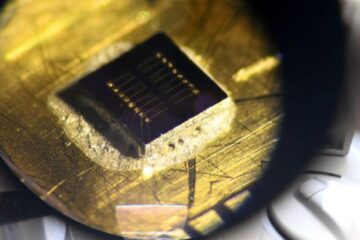New findings implicate cell size controls in a variety of diseases

Basic research into a tumor suppressor gene that controls cell size has uncovered a link between three different genetic diseases and points to a possible treatment for all of them.
The tie that binds these three seemingly disparate medical conditions is a biochemical chain of events that govern cell size. At the end of this chain, a known drug may work to replace missing or broken parts of the biochemical chain.
“We were doing basic cell biology, investigating how cell growth is coordinated with the cell’s energy level,” said Kun-Liang Guan, research professor at the University of Michigan Life Sciences Institute. “We found this story that connects all these things together in a logical manner.”
Guan, who is also a professor of biological chemistry and a MacArthur Foundation fellow, and postdoctoral fellow Ken Inoki have been investigating the general question of how cell growth is regulated because it can be a factor in cancerous cell growth.
In a study published in the Nov. 26 edition of Cell, the researchers describe how a cell growth regulator gene called TSC2 responds to different levels of available energy, such as the sugar glucose. As expected, they found that TSC2 activity is stepped up in response to energy starvation, which means the cell’s growth rate is being slowed to accommodate the less favorable growing conditions.
TSC1 and TSC2 take their name from a kind of tumor. Tuberous sclerosis is a genetic disease in which benign tumors may grow in the brain and nervous system throughout a person’s life. Its severity can range from learning disabilities and epilepsy to severe mental retardation and uncontrollable seizures. There is no cure for tuberous sclerosis, but symptoms may be treated with medications to control seizures and behavior problems.
The genes TSC1 and TSC2 make two proteins that bind together to form a complex which helps control a cell’s growth and its final size. A defect in either gene can lead to tuberous sclerosis.
In watching how the cell responded to energy shortages, the Guan lab identified a molecule called AMPK that makes TSC2 work harder in starvation conditions.
Though it wasn’t known previously that AMPK was performing this function, the molecule had earlier been implicated in Wolf-Parkinson-White Syndrome, a genetic disease marked by problems in the electrical circuitry of the heart muscle and cardiac hypertrophy, an abnormally enlarged heart.
Upstream in the biochemical reaction from AMPK is another molecule known as LKB1, which was identified by other researchers. Defects in LKB1 are associated with Peutz-Jagers Syndrome, in which benign polyps proliferate in the intestines and stomach, and dark pigmentation appears around the mouth, eyes and nostrils of children under 5.
Guan earlier established that the TSC complex’s job is to limit the activity of a molecule called mTOR, which is a key player in cell growth, protein-making and viability. Now, it’s clear that these other molecules act upstream of mTOR, and that a defect in each of them means a different disease.
Taken together, the chain of events is now known to work like this:
More LKB1 means more AMPK. That means more TSC2, and that, in turn, means less mTOR, which has the result of limiting cell growth. Knock out any of those elements upstream from mTOR, and you have the opposite effect—more cell growth.
This is where Guan scoots forward in his chair excitedly. He recently learned that researchers at the Cincinnati Children’s Hospital are experimenting with the drug Rapamycin to regulate mTOR activity. He has to wonder: what if Rapamycin, which has FDA approval for use as an anti-rejection drug in organ transplants, could also be used to treat these genetic syndromes?
That is, if somebody has a genetic disorder because their AMPK or LKB is missing or malformed, could the role of regulating mTOR be replaced by the drug?
That’s the next question Guan and his team will turn to, working with their Life Sciences Institute colleagues. Guan wants to collaborate with LSI geneticist David Ginsburg on developing mice that mimic the genetic disorders so that further study can be done on the biochemical chain of events. And Guan wants to connect with LSI cell biologist Daniel Klionsky to look for parallels between this mammalian version of TOR (mTOR), and a molecule Klionsky studies in yeast called just TOR which performs similar functions.
“It will be great to have Dan as my neighbor,” said Guan, whose office is just steps away from Klionsky’s on the sixth floor of the new LSI. “This is the sort of thing this institute is all about.”
The paper is “TSC2 Mediates Cellular Energy Response to Control Cell Growth and Survival,” Ken Inoki, Tianqing Zhu and Kun-Liang Guan, Cell, Vol. 115, Nov. 26, 2003.
Media Contact
All latest news from the category: Health and Medicine
This subject area encompasses research and studies in the field of human medicine.
Among the wide-ranging list of topics covered here are anesthesiology, anatomy, surgery, human genetics, hygiene and environmental medicine, internal medicine, neurology, pharmacology, physiology, urology and dental medicine.
Newest articles

Sea slugs inspire highly stretchable biomedical sensor
USC Viterbi School of Engineering researcher Hangbo Zhao presents findings on highly stretchable and customizable microneedles for application in fields including neuroscience, tissue engineering, and wearable bioelectronics. The revolution in…

Twisting and binding matter waves with photons in a cavity
Precisely measuring the energy states of individual atoms has been a historical challenge for physicists due to atomic recoil. When an atom interacts with a photon, the atom “recoils” in…

Nanotubes, nanoparticles, and antibodies detect tiny amounts of fentanyl
New sensor is six orders of magnitude more sensitive than the next best thing. A research team at Pitt led by Alexander Star, a chemistry professor in the Kenneth P. Dietrich…





















